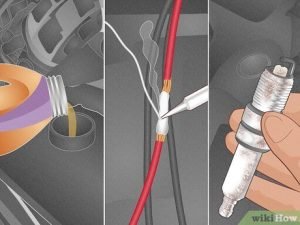Choosing the right tires for your vehicle is a crucial decision, and it’s not always as simple as just walking into a store and picking the first ones you see. Understanding the numbers and letters on tire sidewalls, such as 265/70R17 and 285/70R17, is the first step to making an informed choice. In this easy-to-understand guide, we’ll break down these tire sizes and explore their pros and cons, helping you decide which one is the best fit for your needs. Whether you’re a daily commuter, a weekend adventurer, or an off-road enthusiast, we’ve got you covered with essential information to make the right tire choice.
Contents
Understanding Tire Size
Tire size might seem like a bunch of confusing numbers and letters, but it’s not as complex as it seems. Let’s break it down into simple terms:
- Breaking Down the Numbers (265 and 285):
- The first numbers (e.g., 265 and 285) represent the width of the tire in millimeters. So, a 265 tire is 265 millimeters wide, and a 285 tire is 285 millimeters wide. Generally, a wider tire provides more contact with the road.
- The Meaning of 70:
- The number 70 here represents the aspect ratio, which is the tire’s height as a percentage of its width. In this case, it means the tire’s height is 70% of its width. A higher aspect ratio (e.g., 70) often results in a taller sidewall, which can impact ride comfort.
- The Significance of R17:
- The “R” stands for “radial,” which is the most common type of tire construction. The number 17 indicates the diameter of the wheel or rim in inches. So, these tires are designed to fit on 17-inch wheels.
- How Tire Size Affects Performance:
- The tire size affects several aspects of your vehicle’s performance. Wider tires (e.g., 285) can offer more stability and grip, which is great for off-road adventures and sporty driving. Narrower tires (e.g., 265) might provide better fuel efficiency and a smoother ride for daily commuting.
Understanding these basics will help you make a more informed decision when choosing between tire sizes like 265/70R17 and 285/70R17. Next, we’ll explore the specific advantages and disadvantages of each size to help you decide which one suits your needs best.
Overview of 265/70R17 and 285/70R17 Tire Sizes
Now that we’ve broken down the numbers, let’s take a closer look at the 265/70R17 and 285/70R17 tire sizes to understand what makes them unique:
265/70R17:
- Width (265 millimeters): This tire is 265 millimeters wide. It’s narrower compared to the 285 tire, which means it might be more fuel-efficient and offer a smoother on-road ride for daily commuting.
- Aspect Ratio (70): With a 70 aspect ratio, the sidewall of this tire is relatively taller. This can contribute to a more comfortable and cushioned ride, absorbing bumps on the road.
- Wheel Size (17 inches): These tires are designed to fit 17-inch wheels, which are common on many vehicles. They offer a good balance between comfort and performance.
285/70R17:
- Width (285 millimeters): The 285 tire is wider, providing more contact with the road. This extra width can enhance stability, traction, and grip, which is particularly useful for off-road adventures and sportier driving.
- Aspect Ratio (70): Like the 265 tire, it has a 70 aspect ratio, indicating a relatively taller sidewall. This can contribute to a more comfortable ride but isn’t as pronounced as with lower aspect ratios.
- Wheel Size (17 inches): Just like the 265, these tires are designed for 17-inch wheels, making them compatible with many vehicles.
The 265/70R17 tire is narrower and offers a comfortable on-road ride, making it suitable for daily commuting. On the other hand, the 285/70R17 tire is wider and provides enhanced stability and grip, making it a good choice for off-road enthusiasts and those who want sportier performance.
In the next sections, we’ll delve deeper into the pros and cons of each size to help you decide which one aligns better with your specific needs and preferences.
Pros and Cons of 265/70R17 Tires
Before making a decision, it’s essential to consider the advantages and disadvantages of 265/70R17 tires:
Pros:
- Fuel Efficiency: The narrower width of 265 tires can lead to better fuel efficiency. They create less rolling resistance, which means your vehicle won’t have to work as hard to move forward, ultimately saving you on gas.
- Ride Comfort: With a taller sidewall (aspect ratio of 70), these tires provide a smoother and more comfortable ride. They can absorb bumps and imperfections in the road, making your daily commute or long drives more pleasant.
- Reduced Road Noise: The taller sidewalls also help dampen road noise. This results in a quieter cabin, enhancing the overall driving experience and reducing driver fatigue.
Cons:
- Off-Road Performance: While 265/70R17 tires can handle light off-road conditions, they might not provide the same level of traction and grip as wider tires. If you’re an avid off-road enthusiast, you may want to consider wider tire options for better off-road capabilities.
- Ground Clearance: These tires don’t significantly increase your vehicle’s ground clearance. If you frequently encounter rough or uneven terrain, a tire with a larger diameter or more aggressive tread pattern might be more suitable.
265/70R17 tires are a solid choice for everyday driving, offering good fuel efficiency, ride comfort, and reduced road noise. However, if you require exceptional off-road capabilities or additional ground clearance, you might want to explore wider tire options or consider your specific driving needs when making your decision.
Pros and Cons of 285/70R17 Tires
To make an informed decision, let’s examine the advantages and disadvantages of 285/70R17 tires:
Pros:
- Off-Road Capability: The wider width (285 millimeters) of these tires provides excellent traction and grip, making them well-suited for off-road adventures. They can handle rough terrain, mud, and uneven surfaces with ease.
- Traction and Grip: Wider tires generally offer superior traction, whether you’re on or off the road. This enhanced grip can be beneficial in various driving conditions, including wet or slippery roads.
- Aesthetic Appeal: Many people find the wider stance of 285/70R17 tires visually appealing. They can give your vehicle a more rugged and aggressive look.
Cons:
- Fuel Economy: Wider tires tend to have higher rolling resistance, which can lead to slightly lower fuel efficiency compared to narrower tires like the 265/70R17. You may notice a small decrease in miles per gallon.
- Road Noise: Wider tires can generate more road noise, especially at highway speeds. This may result in a louder cabin environment during your daily drives.
285/70R17 tires are an excellent choice if you prioritize off-road performance, traction, and a more aggressive appearance for your vehicle. However, you should be prepared for a potential decrease in fuel efficiency and increased road noise, which are common trade-offs with wider tires. Consider your specific driving needs and preferences when deciding if these tires are right for you.
Factors to Consider When Choosing Between 265/70R17 and 285/70R17 Tires
Now that we’ve explored the pros and cons of both tire sizes, let’s consider some key factors to help you make an informed decision:
- Vehicle Type and Use:
- Daily Commuting: If you primarily use your vehicle for daily commuting and highway driving, 265/70R17 tires may be more suitable due to their better fuel efficiency and ride comfort.
- Off-Roading: If you’re an off-road enthusiast or frequently drive on rough terrain, 285/70R17 tires are a better choice. They offer superior traction and durability for off-road adventures.
- Climate and Driving Conditions:
- Wet or Snowy Climates: In areas with frequent rain or snow, wider tires like 285/70R17 can provide better grip and stability, enhancing your safety in adverse weather conditions.
- Dry Climates: If you live in a predominantly dry and sunny region, 265/70R17 tires may suffice for everyday driving.
- Budget Considerations:
- Purchase Price: Typically, 265/70R17 tires are more affordable than their wider counterparts, which can be an important consideration if you’re on a budget.
- Operating Costs: Remember to factor in potential differences in fuel efficiency when calculating long-term operating costs.
- Personal Preferences:
- Ride Comfort: Consider how important a comfortable and quiet ride is to you. If you prioritize comfort, the 265/70R17 tires with their taller sidewalls might be preferable.
- Aesthetic Appeal: Some drivers prefer the rugged appearance of wider tires like the 285/70R17, which can enhance the overall look of your vehicle.
- Driving Habits:
- Highway vs. Off-Road: Evaluate the proportion of highway driving versus off-road or adventurous driving you do. Your tire choice should align with your driving habits.
- Consulting Experts:
- It’s always a good idea to consult with tire professionals or your vehicle manufacturer for specific recommendations tailored to your vehicle model and driving needs.
Tthe choice between 265/70R17 and 285/70R17 tires depends on various factors, including your vehicle, driving conditions, budget, and personal preferences. Assessing these factors will help you make the right decision that best suits your needs and ensures a safe and enjoyable driving experience.
Real-World Examples
Let’s explore some real-world scenarios to illustrate how the choice between 265/70R17 and 285/70R17 tires can impact your driving experience:
Scenario 1: The Daily Commuter
Meet Sarah. She commutes to work five days a week and spends most of her driving time on well-maintained city roads and highways.
- Tire Choice: Sarah opts for 265/70R17 tires.
- Why: These tires provide a smoother ride and better fuel efficiency, making her daily commute comfortable and cost-effective. Plus, the reduced road noise ensures a peaceful drive.
Scenario 2: The Weekend Adventurer
John loves weekend getaways, whether it’s camping in the woods or exploring scenic trails.
- Tire Choice: John goes for 285/70R17 tires.
- Why: With their superior off-road capabilities and excellent traction, these tires allow John to confidently tackle various terrains during his adventures. Their wider stance gives him added stability on dirt roads and muddy trails.
Scenario 3: The Off-Road Enthusiast
Meet Mark, an avid off-road enthusiast who enjoys challenging trails and rocky paths.
- Tire Choice: Mark chooses 285/70R17 tires.
- Why: Mark’s passion for off-roading demands the extra grip and durability that wider tires offer. They provide him with the traction needed to conquer steep inclines and rocky obstacles, ensuring a thrilling off-road experience.
These real-world examples highlight how tire choice depends on individual driving habits and preferences. While Sarah prioritizes a comfortable daily commute, John seeks adventure on weekends, and Mark craves off-road thrills. Your specific needs and usage patterns should guide your decision between 265/70R17 and 285/70R17 tires to ensure they align with your driving lifestyle.
Conclusion
Choosing between 265/70R17 and 285/70R17 tires is a decision that impacts your vehicle’s performance and your overall driving experience. Let’s recap what we’ve learned and offer some final guidance:
- 265/70R17 Tires: These tires are narrower and are ideal for daily commuting. They offer better fuel efficiency, a smoother ride, and reduced road noise. If you prioritize comfort and cost-effectiveness in your everyday driving, these may be the right choice.
- 285/70R17 Tires: Wider tires like these excel in off-road conditions, providing superior traction and grip. They also have a more aggressive appearance. If you enjoy off-road adventures, need enhanced stability, or simply prefer a rugged look for your vehicle, these tires are worth considering.
When making your decision, consider the following:
- Your vehicle type and use: Determine whether your driving consists mainly of daily commuting, off-road adventures, or a mix of both.
- Climate and driving conditions: Consider the weather and terrain you encounter in your area. Wider tires can provide better traction in wet, snowy, or off-road conditions.
- Budget: Evaluate the upfront cost of the tires as well as long-term operating costs, including potential changes in fuel efficiency.
- Personal preferences: Think about your ride comfort and the visual appeal you desire for your vehicle.
- Driving habits: Reflect on your driving patterns, including highway vs. off-road usage.
Consulting with tire professionals or your vehicle manufacturer can provide valuable insights tailored to your specific needs.
In the end, the choice between 265/70R17 and 285/70R17 tires is about finding the right balance between your driving requirements, preferences, and budget. By considering these factors carefully, you can confidently select the tires that will enhance your driving experience and keep you safe on the road, whether you’re commuting to work, embarking on weekend adventures, or exploring the great outdoors.
Additional Resources
To further assist you in your tire selection process and help you make an informed decision, here are some additional resources and tips:
- Tire Retailers: Visit reputable tire retailers or local tire shops. Their knowledgeable staff can provide expert guidance and help you choose the right tires for your specific vehicle and needs.
- Online Tire Retailers: Many online platforms offer a wide selection of tires, along with customer reviews and ratings to help you make an informed choice. Websites like Tire Rack and Discount Tire Direct can be valuable resources.
- Manufacturer Websites: Explore the websites of tire manufacturers like Michelin, Bridgestone, Goodyear, and others. They often provide detailed information about their tire models, including specifications and performance characteristics.
- Tire Buying Guides: Look for comprehensive tire buying guides from automotive websites and magazines. These guides typically include reviews, comparisons, and recommendations for various tire sizes and types.
- Owner’s Manual: Refer to your vehicle’s owner’s manual for tire size recommendations provided by the manufacturer. It’s essential to ensure that the tires you choose are compatible with your vehicle.
- Online Forums and Communities: Engage with online automotive forums and communities where you can ask questions and seek advice from fellow car enthusiasts who may have experience with the specific tire sizes you’re considering.
- Professional Advice: If you’re uncertain about which tires to choose, consider consulting with a professional mechanic or tire specialist. They can assess your vehicle, driving habits, and local conditions to offer personalized recommendations.
- Tire Maintenance: Once you’ve chosen your tires, don’t forget to maintain them properly. Regularly check tire pressure, rotate your tires as recommended by the manufacturer, and ensure proper wheel alignment to maximize their lifespan and performance.
- Consumer Reports and Safety Ratings: Review tire ratings and safety information from sources like Consumer Reports and government agencies. These resources can provide insights into the safety and performance of different tire models.
- Customer Feedback: Read reviews and feedback from other drivers who have purchased the same tire size you’re considering. Their experiences can offer valuable insights into real-world performance.
Remember that choosing the right tires is an investment in your safety and driving satisfaction. Taking the time to research, consult experts, and consider your unique driving needs will help you make a confident and informed decision when selecting between 265/70R17 and 285/70R17 tires.
Frequently Asked Questions
- What do the numbers in tire sizes like 265/70R17 and 285/70R17 mean?
- The first number (e.g., 265 or 285) represents the tire’s width in millimeters.
- The second number (e.g., 70) is the tire’s aspect ratio, indicating the height of the tire’s sidewall as a percentage of its width.
- The letter “R” stands for radial tire construction.
- The last number (e.g., 17) indicates the diameter of the wheel or rim in inches that the tire is designed to fit.
- Which tire size is better for fuel efficiency, 265/70R17, or 285/70R17?
- Generally, 265/70R17 tires tend to offer better fuel efficiency compared to wider 285/70R17 tires due to their narrower width, which results in less rolling resistance.
- Are wider tires better for off-road driving?
- Yes, wider tires like 285/70R17 tend to perform better in off-road conditions. They provide increased traction and grip on rough terrain, making them suitable for off-road enthusiasts.
- Do wider tires (285/70R17) make a vehicle look more rugged?
- Yes, wider tires can give a vehicle a more rugged and aggressive appearance. Many people choose wider tires for aesthetic reasons.
- Do 265/70R17 or 285/70R17 tires affect road noise differently?
- Generally, 265/70R17 tires with their taller sidewalls may produce less road noise compared to wider 285/70R17 tires, especially at highway speeds.
- Can I mix tire sizes on my vehicle?
- It’s not recommended to mix tire sizes on the same axle or vehicle. Different tire sizes can affect handling and stability. Always consult your vehicle’s owner’s manual or a tire professional for guidance.
- Which tire size is better for winter driving?
- For winter driving, narrower tires like 265/70R17 may be more effective because they can cut through snow and slush with greater ease. However, winter tires specifically designed for cold weather conditions are often the best choice.
- How do I know if a tire size is compatible with my vehicle?
- Check your vehicle’s owner’s manual or the label inside the driver’s door jamb for the manufacturer’s recommended tire size. Using the recommended size ensures compatibility and safety.
- Can I change my tire size without affecting my vehicle’s performance?
- Changing your tire size can impact your vehicle’s performance, including speedometer accuracy, handling, and fuel efficiency. Consult with a tire professional to select a size that won’t negatively affect your vehicle.
- What’s the difference in price between 265/70R17 and 285/70R17 tires?
- Generally, 265/70R17 tires are more affordable than their wider counterparts (285/70R17). Prices can vary depending on the tire brand, model, and specific features.
Affiliate Disclosure: As an Amazon Associate, I earn from qualifying purchases made through links on this site.











